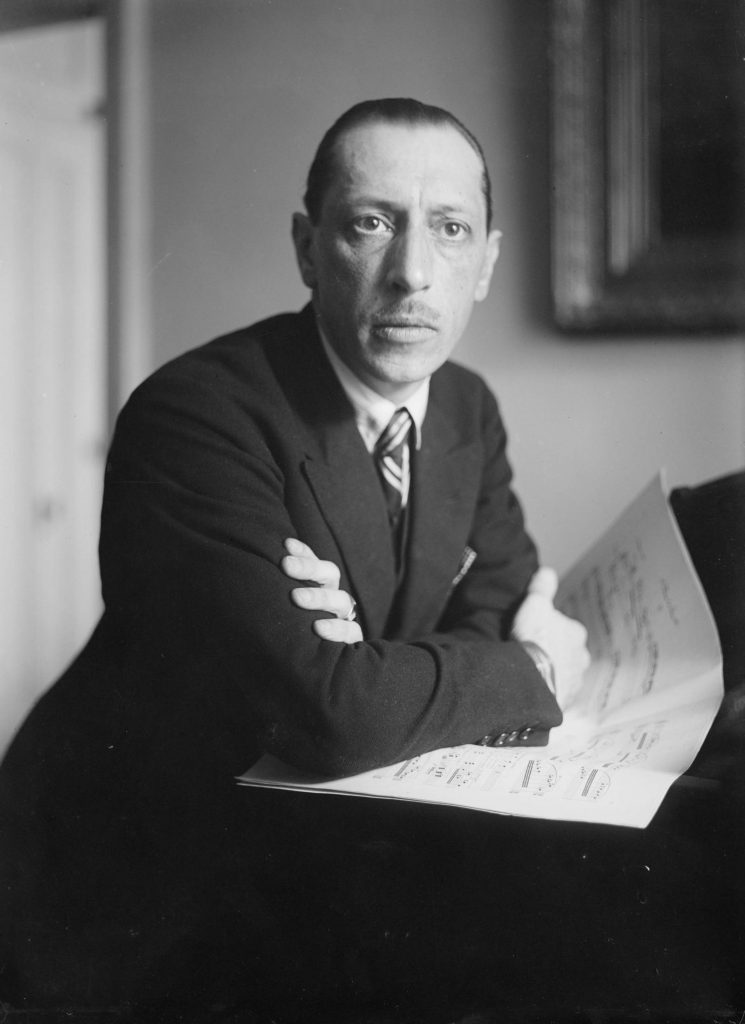Coming to America: Stravinsky goes West in New World program

One of the many strokes of luck in Igor Stravinsky’s long life was his decision to move to the United States just before the Wehrmacht marched into his adopted city of Paris.
He settled in Los Angeles, where Sergei Rachmaninoff, Arnold Schoenberg and other big names in classical music also would trade the charms of old Europe for southern California’s sunshine, beaches and tennis courts.
The New World Symphony presented “Stravinsky in America” Saturday night, an online concert devoted to the composer’s work in the United States. (The orchestra examined Stravinsky’s French sojourn last week with “Stravinsky in Paris.”)
Hosting the concert was New World artistic director Michael Tilson Thomas, who as a young man in Los Angeles knew and worked with Stravinsky.
“He was small in stature but very precise and elegant,” Tilson Thomas said. “He was still like somebody living in St. Petersburg from all of those years ago. He had a great sense of style, as he pulled out colored pencils from his many vests, and he was fascinated by languages, constantly translating from one language to another and looking things up in dictionaries and encyclopedias.”
“He played piano a lot, not only a real piano but a kind of phantom piano, his fingers moving, imagining new sounds. He was thrilling to be around.”
The concert focused on a part of Stravinsky’s career commonly called his “Neoclassical” period, characterized by works that were bustling, rhythmic and cerebral. Yet as the evening made clear, the Neoclassical label doesn’t always provide the most reliable summation of this body of work.
The elegant melody of the Arioso from the Concerto in D for String Orchestra, for example, seemed to recall music from Stravinsky’s upbringing in the Russia of Tchaikovsky and Rimsky-Korsakov. Led by former New World conducting fellow Joshua Gersen, the string players brought a yearning feeling to the long melodies, with an emotional restraint that put a premium on style and grace. The concluding Rondo, with its tremolos and clipped phrases, came off as tensely dramatic.
The Concerto for Chamber Orchestra known as “Dumbarton Oaks” was consciously inspired by the Baroque period, in particular the Brandenburg concertos of Bach, rather than the Classical era. Gersen’s musical direction and the virtuosity of the New World musicians gave this orchestral work the transparency and incisive clarity of work for a small chamber ensemble. They emphasized the glinting dissonances that give the music so much of its new-old flavor, with a fine sense of musical momentum.
The concert opened with the Rondoletto from Stravinsky’s Serenade in A for Solo Piano, performed by Wesley Ducote. Although the work has the metronomic drive of a Bach keyboard work, there was nothing mechanical about the performance, with Ducote bringing a lively, not overly serious tone to the performance.
Although the program listed only the last two movements of the Symphony in Three Movements, a work composed during World War II, the concert actually included the whole thing. The performance came from the orchestra’s archives, having been recorded during the early, pre-COVID period last year, conducted by Tilson Thomas.
With blaring horns and thumping basses, the opening Allegro exuded the violence of a work that Stravinsky said had been inspired by the combat in Europe and Asia. Under Tilson Thomas’ direction, the brutality was effectively contrasted by jazzy rhythms and a sense of expectation and momentum.
The Andante featured eerie playing in the winds, creating a misty, moonlit atmosphere. The last movement, with its emphatic rhythms and burst of winds and brass, returned to the energetic tone of the first movement, but without the foreboding tone of violence.
Among Stravinsky’s fellow expats in Los Angeles was Arnold Schoenberg, inventor of 12-tone music, who embraced California life, working on his tennis game and cheering on the UCLA football team.
Stravinsky was influenced by Schoenberg’s system of composition and adopted it late in life. One result was the Septet, composed in the early 1950s. The concert included two of the work’s three movements.
The performance opened with the second movement Passacaglia, a set of variations that has a formal Baroque tone rather than the dark swirl of Schoenberg’s romanticism-tinged music. The musicians gave a finely paced performance, with the tension of the variations rising not simply through turning up the volume but through a deepening of intensity through to the final quiet moments. Although the playing was on-point and well-shaped in the concluding Gigue, the music felt more busy than interesting, with nothing like the force of the preceding movement.
One curiosity on the program was a work by Ingolf Dahl, Stravinsky’s assistant and a teacher to Tilson Thomas. The musicians performed the Allegro from his Concerto a Tre for clarinet, violin and cello, a work composed in 1946.
Performed by clarinetist Jesse McCandless, violinist Jung Eun Kang, and cellist Emily Yoshimoto, this bright, upbeat work had a real neoclassical feel. As the musicians skillfully played the fast-paced passages, melodies bounced from instrument to instrument in the spirit of a Haydn quartet.
Posted in Performances
Leave a Comment
Sun Mar 14, 2021
at 12:57 pm
No Comments






